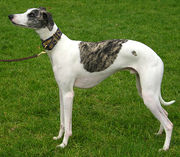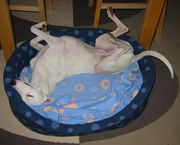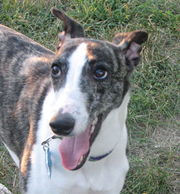Whippet
 |
|||||||||||||||||||||||||
| Whippet | |||||||||||||||||||||||||
| Country of origin | England | ||||||||||||||||||||||||
|---|---|---|---|---|---|---|---|---|---|---|---|---|---|---|---|---|---|---|---|---|---|---|---|---|---|
|
|||||||||||||||||||||||||
|
|||||||||||||||||||||||||
| Dog (Canis lupus familiaris) | |||||||||||||||||||||||||
The Whippet is a breed of dog in the sighthound family. They are active and playful and are physically similar to a small greyhound. Their popularity has led to the reuse of the Whippet name on a large number of things, from cars to cookies.
Contents |
Description
Whippets are a medium-size dog averaging in weight from 15 to 30 lb (6.8–14 kg), with height (under the FCI standard) of 18.5 - 20 inches (47 - 51 cm) for males and 17.5–18.5 inches (44–47 cm) for females. Whippets tend to be somewhat larger in the United States and Canada with their population in show, coursing and some race whippets required to be within the AKC standard of 18.5 to 22.5 inches (47 to 57 cm) for males, and 17.5 to 21.5 inches (44 to 55 cm) for females. Because colour is considered immaterial in judging Whippets, they come in a wide variety of colours and marking patterns, everything from solid black to solid white, with red, fawn, brindle, blue, or cream. All manner of spots and blazes and patches are seen, sometimes all in the same litter.
Temperament
Whippets are generally quiet and gentle dogs, and may be content to spend much of the day resting.[1] Although especially attached to their owners, they are friendly to visitors. Because of their friendly nature, whippets are known to have been used in aged care facilities. They may bark when strangers arrive but are not suited to being guard dogs.
Unlike some other breeds, male whippets are as easy to housebreak as females. Females can be a little more complex, moody and strong-willed. Males tend to be one to two inches taller and three to six pounds heavier than females.

Whippets are not well-adapted for living in a kennel, or as outside dogs. Their short coats do not provide insulation to withstand prolonged periods in cold temperatures. Their natural attachment to people makes them happiest when kept indoors. They are most at home in the company of their owners—in their lap or lying next to them on the lounge. Whippets are quiet and thus well suited to apartment life, although like all dogs they need regular, healthy exercise. The chance to run free in open spaces should be made available to the whippet; however care should be taken with whippets on the street as it is difficult to instil any sort of traffic sense into them.
The whippet may look mild and gentle (and for the most part are), but make no mistake, when in pursuit of any game such as a rabbit the whippet will demonstrate the heart of a lion. Whippets are excellent hunting dogs for small game, which comes from their original role as providers of meat for the table. Often owning a whippet meant the difference between having meat for dinner or not.
Whippets have been called a "poor man's racehorse." As their heritage would suggest, whippets are outstanding running dogs and are top competitors in lure coursing, straight racing, and oval track racing. Typically in these events, a temporary track and lure system is set up. The lure is usually a white plastic trash bag, sometimes in conjunction with a "squawker" to simulate a sort of prey sound or with a small piece of animal pelt. With the advent of new methods in motivational obedience training being used, whippets are becoming successful obedience dogs. Many enjoy flyball and agility.
A May 7, 2007 article in Science Daily[2] reported on a genetic mutation that may account for the abnormally high athletic ability of whippets.
The elegance and ease of grooming of the whippet have made it a somewhat popular in the sport of conformation showing.

Health
Given proper nutrition, exercise, and veterinary care, most whippets live for 12 to 15 years.[3] They are generally healthy, and are not prone to the frequent ear infections, skin allergies, or digestive problems that can afflict other breeds. Genetic eye defects, though quite rare, have been noted in the breed. Because of this the American Whippet Club recommends that all breeders test for this defect in their breeding stock. Hip dysplasia is unknown in whippets. Undescended testicles are common in the breed. Like most sighthounds, they are intolerant of barbiturate anaesthetics.
The heart of a whippet is large and slow beating, often being arrhythmic or even intermittent when the animal is at rest[4] This sometimes causes concern to the owner, or to the vet not experienced with the breed. Whippets will, however, demonstrate a regular heartbeat during exercise. In a health survey conducted by The Kennel Club (UK) cardiac problems were shown to be the second leading cause of mortality in Whippets.[5] It is not clear, however, whether this is at all related to the breed's somewhat unusual heart function. See athletic heart syndrome.
A 2007 study[6] identified a myostatin mutation particular to whippets that is significantly associated with their athletic performance. Whippets with a single copy of this mutation are generally very fast; those with two copies have disproportionately large musculature and are known as "bully whippets" although their temperament is not affected by this.[7][8]
A Whippet owner should take notice that Whippets are, just like other sighthounds, sensitive to a number of anaesthetics. This may be due to their low concentration of body fat. Any Whippet should have a sighthound-knowledgeable veterinarian.[9]
History

Whippets were bred to hunt by sight, coursing game in open areas at high speeds. One can find numerous representations of small greyhound-like hounds in art dating back to Roman times but the first written English use of the word "whippet" with regard to a type of dog was in 1610. There is a picture by Jean Baptiste Oudry (1686–1755) of "Misse", one of two English whippets presented to Louis XV, in the Washington National Gallery and another, with her companion, "Turlu", by the same artist in the Musée National de Fontainebleau. However, some French sources, notably the Ministry of Culture, use the word "levrette" to describe Misse and Turlu. Levrette translates as "female greyhound". In the nineteenth century, whippet racing was a national sport in England, more popular than football. It is only beginning with this period that the existence of the whippet as a distinct breed can be stated with certainty. The age of the modern whippet dawned in 1890 when the English Kennel Club granted the breed official recognition, thus making the whippet eligible for competition in dog shows, and commencing the recording of their pedigrees. In the United States, the whippet was recognized in 1888 by the American Kennel Club. Early specimens were taken from the race track by dog fanciers of the time and exported all over the world. The whippet's versatility as a hunting, racing, exhibition or companion dog soon made it one of the most popular of the sighthound breeds.
References
- ↑ Whippet Information
- ↑ Gene Mutation Linked To Increased Athletic Performance In Whippets
- ↑ Whippet - Canada's Guide to Dogs - Breeds
- ↑ some footnote
- ↑ http://www.thekennelclub.org.uk/download/1642/hswhippet.pdf
- ↑ A Mutation in the Myostatin Gene Increases Muscle Mass
- ↑ Big Wendy story at Canada.com
- ↑ Big Wendy Story at UK Daily Mail
- ↑ http://www.canadasguidetodogs.com/whippet.htm
Whippet (dog information) on petinfospot.com
External links
- Breed Clubs
- Racing and coursing sanctioning bodies
|
|||||||||||